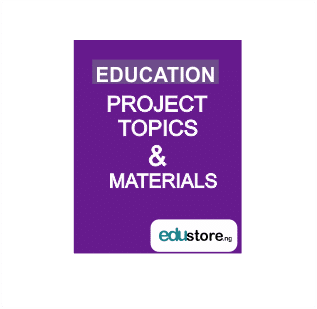EFFECTS OF COMPUTER-ASSISTED INSTRUCTION ON ACADEMIC ACHIEVEMENT AMONG NCE PHYSICS STUDENTS OF DIFFERENT ABILITIES
ABSTRACT
The study investigated the effect of computer- assisted instruction on academic achievement of Nigeria Certificate in Education Physics students of different abilities, in Niger State, Nigeria. Six research questions were raised and six null hypotheses were formulated to guide the study. The study adopted pretest and posttest quasi experimental control group design. Two hundred and eleven (211) NCE II students from the two colleges of education in Niger State were used as research sample. Purposive sampling techniques was used to choose the two schools while balloting method was employed to assign the colleges into experimental and control groups. The researcher developed computer- assisted instructional package on Mechanics and Properties of Matter which was used as treatment instrument for experimental group while control group were exposed to traditional (lecture) teaching method. The instrument for data collection was Mechanics and Properties of Matter Achievement Test (MPMAT) which was validated by experts in science education. A 40- items multiple choice objective type achievement test covering six topics in Mechanics and Properties of Matter was used to collect data for both pretest and posttest. A reliability coefficient of 0.78 was obtained using the data collected from pilot test and analyzed using Pearson‟s Product Moment Correlation Coefficient (r). The data of the first five hypotheses were analyzed using t- test and the sixth hypothesis was analyzed using one way Analysis Of Variance (ANOVA) statistics. The findings of this study revealed that experimental group performed better than the control group, no statistically significant difference in the performances of both male and female students taught using CAI which implies that it is gender friendly and there is no significant difference in the academic achievement among low, medium and high abilities taught using CAI. It was recommended among others, that Physics Lecturers should use computer software in teaching physics in order to enhance student‟s achievement in physics and Physics Lecturers should acquire computer literacy, so that he/she can develop any computer assisted instruction package
1.1 Introduction
The world is becoming more sophisticated technologically. The industrial age gave way to information age, an info-tech era which is as vital as the water we drink because this has brought positive changes to the society, business, education and other facets of human life. In fact, the educational sector is not exempted from the benefit of participation in an information-rich computerized society. To keep to date with the emerging technological changes at the national, regional and global environments, our present educational system is continuously upgrading its resources through the modernization of the various elements of the system. Modernization can be pursed through the introduction of modern instructional aides and materials such as multimedia gadgets like computers, CD-ROM, TV, internet among others (Caday, 2004). Linn (2003) stated that information and communication technology had had a convoluted but ultimately advantageous impact on science teaching.
Computers offer exciting approaches to teaching that were not even dreamt of two decades ago, but the extent to which the educational potential of computer technology will be realized remains to be seen (Amara, 2006). Computer technology has caught the attention of many researchers and educators and computer-based instructional applications are considered effective alternative to traditional teaching method (Yushau, 2006). Research findings explicitly reported that science education and computer technology had created a meaningful partnership over the century (Flick & Bell, 2000). Thomas (2001) argued that very little was known about the use of computer in science classrooms and its effects on students‟ learning.
Get Full Work Now
DOWNLOAD COMPLETE WORK- For Reference Only: Materials are for research, citation, and idea generation purposes and not for submission as your original final year project work.
- Avoid Plagiarism: Do not copy or submit this content as your own project. Doing so may result in academic consequences.
- Use as a Framework: This complete project research material should guide the development of your own final year project work.
- Academic Access: This platform is designed to reduce the stress of visiting school libraries by providing easy access to research materials.
- Institutional Support: Tertiary institutions encourage the review of previous academic works such as journals and theses.
- Open Education: The site is maintained through paid subscriptions to continue offering open access educational resources.




